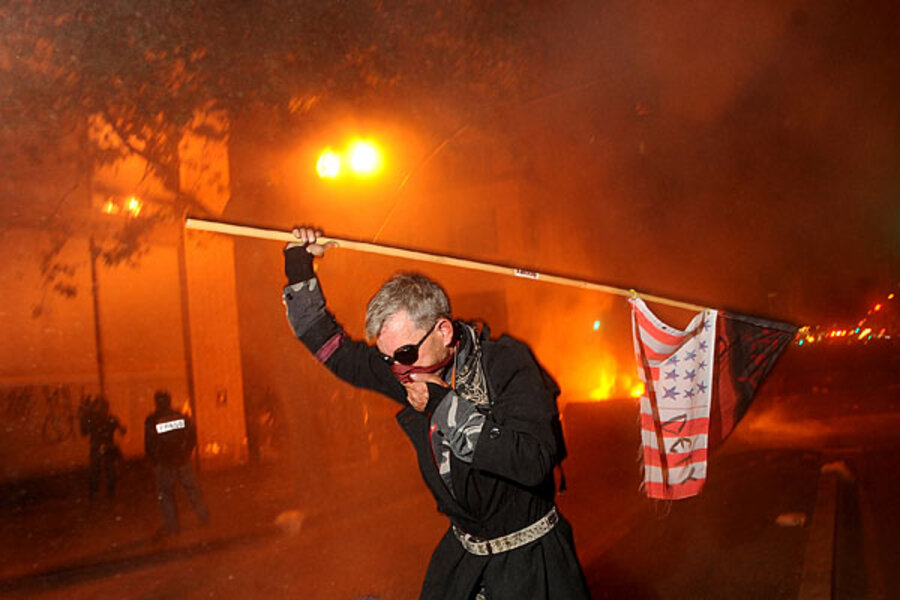Is Occupy Oakland undermining its own message with violence? (VIDEO)
Loading...
Occupy Oakland's call for a general strike Wednesday yielded mixed results. It seems likely that the goal of using the day to launch a similar, nationwide action will suffer because of violence and vandalism that erupted early Thursday, say observers as well as organizers.
But protesters did succeed in shutting down the nation’s fifth busiest port for at least five hours and bringing an estimated 10,000-strong crowd into the streets.
Many, like third-generation Bay area longshore worker Clarence Thomas, had positioned the day of mass action as “a dry run” for the next step – a national, general strike. But overnight things turned sour.
“A small group of people took what was a very successful day of non-violent action by thousands of people from every sector of the city and turned it into hammers breaking windows and violence,” Occupy Oakland media team member Allan Brill said Thursday.
[ Video is no longer available. ]
“Our movement does not endorse violence,” he added. On the contrary, he said many who participated Wednesday talked about the day’s larger impact on activities in other cities. “We would like to see a coordinated national strike coming out of this,” he said.
The conventional wisdom suggests, however, that even without the black eye of vandalism and skirmishes with law enforcement, the likelihood of the Oakland one-day general strike spawning a nationwide unified work stoppage may be remote at best, says Ben Agger, sociology professor at the University of Texas at Arlington. Historically, such mass mobilization has required a vast, unified front, “which traditionally comes from unions.”
But, with a serious decline in union membership in the US as well as what he calls the “lack of class identification,” general strikes are unlikely to spread.
Union membership is now under 10 percent of the national workforce, Professor Agger says. “How many of white collar and pink collar workers identify themselves with the working class?” Not many.
Even though many unions – teachers, nurses, carpenters, and even the longshore workers – endorsed Oakland’s call to action, they stopped short of calling their members out for an official strike, despite the Bay Area longshore workers' progressive tradition, says Dartmouth assistant sociology professor Marc Dixon.
But some say the Internet has turned many of these assumptions upside down, largely because it crosses all boundaries of time and social class so easily.
“This is everybody’s movement,” says New York brand consultant David Intrator. Mr. Intrator says he embraces the movement’s message of anti-corporate greed as a means to bring back a healthy and functioning capitalism.
The Internet does change the game plan of traditional mass mobilizations, agrees Agger from the University of Texas. What may begin to emerge is an ongoing call to action across political and geographical boundaries, or “a sort of perpetual revolution,” without hierarchical leadership, he says.
If the current online calls to action in solidarity with the Occupy movement are any measure, violence in Oakland has had little if any dampening effect on the growing digital calendar of mass actions around the world.
On Thursday for example, National Nurses United, a union and professional association of registered nurses, joined many others calling for protests at the G20 meeting in Cannes, France. And voices urging action on the so-called Bank Transfer Day scheduled for Nov. 5, are also tapping into the Occupy movement momentum.
If any city could help fan such broader actions, Oakland has a particular legacy of focusing national sentiment, says Chris Rhomberg, associate professor of sociology at Fordham University.
“The 1946 Oakland general strike was part of the 1946 national strike wave, the largest in American history. It represented the aspirations of a whole generation of Americans coming out of the Great Depression and World War II," Professor Rhomberg wrote in an e-mail Thursday.
Now, he says, the country is at the other end of that era. “Dramatic increases of inequality in wealth and income, and the domination of money in our political system, have led ordinary people to demand the restoration of our citizenship rights,” he wrote.





